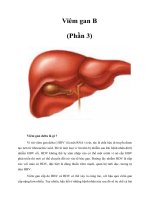Tài liệu Neurodegenerative Biomarkers in Healthy Elderly docx
Bạn đang xem bản rút gọn của tài liệu. Xem và tải ngay bản đầy đủ của tài liệu tại đây (3.52 MB, 120 trang )
Neurodegenerative Biomarkers
in Healthy Elderly
– with special reference to the preclinical pattern of
biological and cognitive markers for Alzheimer’s disease
Erik Stomrud, MD
Clinical Memory Research Unit
Department of Clinical Sciences, Malmö
Faculty of Medicine
Doctoral Thesis
With due permission of the Faculty of Medicine at Lund University to be
publicly defended on December 12, 2009 at 9.00 am, in the Main Lecture
Hall at the Clinical Research Centre (CRC), Malmö University Hospital,
Entrance 72, Malmö, Sweden
Supervisors External Faculty Examiner
Elisabet Londos, Associate professor Maria Eriksdotter-Jönhagen,
Lennart Minthon, Associate professor Associate professor
Oskar Hansson, Associate professor Karolinska Institutet
Lund University Stockholm, Sweden
Chair at Thesis Defence Examination Board
Bengt Jeppsson, Professor Henrik Anckarsäter, Professor
Lund University Göteborg University
Martin Ingelsson, Associate professor
Uppsala University
Åsa Westrin, Associate professor
Lund University
Malmö 2009
180
Neurodegenerative Biomarkers
in Healthy Elderly
– with special reference to the preclinical pattern of
biological and cognitive markers for Alzheimer’s disease
Erik Stomrud, MD
Clinical Memory Research Unit
Department of Clinical Sciences, Malmö
Faculty of Medicine
Lund University, Sweden
Malmö 2009
© Erik Stomrud 2009
ISSN 1652-8220
ISBN 978-91-86443-05-4
Lund University, Faculty of Medicine Doctoral Dissertation Series 2009:116
Layout and printed in Malmö, Sweden by Medicinsk Informationsteknik, 2009
“The important thing in science is not so
much to obtain new facts as to discover
new ways of thinking about them”
Sir William Bragg
ABSTRACT ENGLISH
Neurodegenerative Biomarkers in Healthy Elderly
– with special reference to the preclinical pattern of biological and cognitive
markers for Alzheimer’s disease
Erik Stomrud, MD
Background: Alzheimer’s disease (AD) is a neurodegenerative disorder char-
acterized by tau and amyloid brain pathology. With the gradual degeneration of
neurons, cognitive symptoms will arise and the affected individual will eventu-
ally develop AD dementia. The neuropathologic hallmarks of AD have been
observed also in cognitively healthy individuals, which has led to the assump-
tion that the disorder has a long preclinical phase. Several biological markers
for detecting and predicting AD have been validated over the years, where CSF
biomarkers are one of the most recent and accurate markers. The generally per-
ceived notion today is that these biological markers will be altered also in the
preclinical phase. An additional aspect is that a review made in this thesis of
the control samples in CSF articles, suggests that controls have been selected
without efforts to minimize the misclassication of preclinical AD individuals.
Therefore the aim of this study was to investigate biological and cognitive mark-
ers for AD in a group of cognitively healthy elderly individuals who were used
as clinical control subjects in research studies.
Setting: The study sample consisted of 62 cognitively healthy elderly individuals
from a clinical control group. They were followed for 4.5 years at three occasions
and underwent assessments of EEG activity and regional cerebral blood ow
(rCBF) as well as repeated assessments of cognitive function and CSF biomarker
levels. The CSF biomarkers were Aβ42, total tau (t-tau) and hyperphosphorylated
tau (p-tau). The cognitive testing included among others the MMSE, the ADAS-
cog, cognitive speed (AQT), and subjective memory impairment.
Results: In the sample there were individuals with clinically pathological
assessments on each separate biological marker. CSF Aβ42 levels predicted
development of subjective memory impairment affecting quality of life at the
3-year follow-up and correlated with delayed word recall and cognitive speed at
the 4.5- year follow-up. Additionally, the individuals with decreasing CSF Aβ42
levels during the follow-up performed cognitively worse than those with stable
levels at the 4.5-year follow-up. CSF tau levels on the other hand correlated with
an increase of the low-frequent theta activity on EEG and showed covariance
with rCBF in the right medial frontal lobe and the left fronto-parieto-temporal
area. In each case the correlations were stronger for p-tau levels compared to
t-tau levels. Increase in theta activity was also correlated with slower cognitive
speed.
Discussion: In this group of cognitively healthy elderly individuals there were
individuals with deteriorated cognitive and biological markers associated with
AD. These markers further correlated to one another in specic patterns, where
it was the known AD-associated changes of the markers (i.e. low CSF Aβ42,
high CSF t-tau and p-tau, decreased EEG rhythm, and decreased rCBF) that
were primarily related. The ndings could imply that the biomarkers might
indicate early neurodegenerative changes of the brain and that these changes
could be detectable before extensive cognitive impairment. The ndings could
also suggest that preclinical AD might be present in this “healthy” study sample.
Hence, pathological processes prevailing in AD might bridge the clinically
created arbitrary division of normal and non-normal aging of the brain.
SAMMANFATTNING SVENSKA
Neurodegenerativa biomarkörer hos friska äldre
– med fokus på tidiga förändringar av biologiska och kognitiva markörer vid
Alzheimers sjukdom.
Erik Stomrud
Alzheimers sjukdom är den vanligaste demenssjukdomen och cirka 14 miljoner
personer världen över lever med Alzheimers demens. En person som insjuknat i
en demenssjukdom får problem med minnet och/eller andra intellektuella funk-
tioner som leder till svårigheter att klara av vardagen. Vid Alzheimers sjukdom
beror detta på att de två proteinerna amyloid och tau omsätts felaktigt och in-
lagras i hjärnan i form av senila plack och tangles, vilka kan ses vid mikrosko-
pisk undersökning av hjärnvävnaden. Denna felaktiga omsättning leder till att
nervcellerna i hjärnan fungerar sämre och att de till slut bryts ned med förlust
av hjärnvävnad som följd. Mycket talar dessutom för att dessa processer vid
Alzheimers sjukdom startar era decennier innan den drabbade personen får
problem med minnet.
Det nns idag era undersökningar och tester för att påvisa dessa sjukdoms-
processer. En av de markörer som har visat sig vara bäst på att urskilja personer
med Alzheimers demens från friska individer är analys av ryggvätska. Här mäts
mängden av en speciell typ av proteinet amyloid (Ab42) samt totala mängden
av proteinet tau (t-tau) och mängden hyperfosforylerat tau (p-tau). Utöver detta
kan vid Alzheimers sjukdom förändringar ses även av den elektriska aktivite-
ten i hjärnan (EEG-undersökning) och av blodödet i olika delar av hjärnan
(SPECT-undersökning). Eftersom sjukdomsprocesserna vid Alzheimers sjuk-
dom tros föregå försämrat minne, har det spekulerats i att även dessa undersök-
ningar skulle kunna påvisa sjukdomstecken innan minnet påverkas.
I avhandlingen redovisas en sammanställning av urvalsprocessen för de friska
kontroller som har använts inom forskning om ryggvätskemarkörer. Samman-
ställningen visar att individerna väljs enbart utifrån minnestester och att i en
tredjedel av fallen har individerna haft subjektiva problem med minnet. Efter-
som sjukdomsprocesserna troligen börjar långt innan minnesproblemen visar
sig nns det därmed en stor risk att individer med Alzheimers sjukdom i dessa
studier bedömts som friska äldre, vilket kan påverka resultaten i studierna. Där-
för valde jag i denna avhandling att i en grupp intellektuellt friska äldre individer
studera biologiska och intellektuella markörer som i tidigare studier visat sam-
band med Alzheimers sjukdom.
I studien följdes 62 stycken intellektuellt friska äldre individer med olika
tester under 4,5 år. De genomgick upprepade minnestester, ryggvätskeprov
vid två tillfällen, en EEG-undersökning och en SPECT-undersökning. Flera
intellektuella funktioner testades, däribland närminne, intellektuell snabbhet och
subjektiva minnesproblem. Ryggvätskeprovet innebar att ryggvätska tappades ut
från ländryggen och att nivåerna av proteinerna Ab42, t-tau och p-tau mättes.
I studien sågs att det för varje specikt test av de biologiska markörerna fanns
individer med värden som i en klinisk vardag skulle ha bedömts som avvikande.
Vidare sågs i gruppen att de undersökta markörerna var relaterade till varandra i
specika mönster. Lägre nivåer av proteinet Ab42 i ryggvätskan kunde förutsäga
sannolikheten att utveckla subjektiva minnesproblem efter 3 år men hade
också ett samband med sämre resultat på minnestester avseende närminne och
intellektuell snabbhet vid uppföljningen efter 4,5 år. Höga nivåer av t-tau och
p-tau hade däremot ett samband med förlångsammad elektrisk aktivitet framför
allt i bakre delen av hjärnan men även med sänkt blodöde i den främre högra
hjärnhalvan och ökat blodöde i den bakre vänstra hjärnhalvan. Förlångsammad
elektrisk aktivitet var också relaterat till sänkt intellektuell snabbhet.
Studien visade således samband mellan de undersökta markörerna i en grupp
intellektuella friska äldre individer. Vid en närmare genomgång kunde detta
samband ses just mellan de förändringar som i tidigare studier visat samband med
Alzheimers sjukdom. Resultaten skulle kunna tala för att sjukdomsprocesserna
vid Alzheimers sjukdom även nns hos friska äldre samt att de i studien
undersökta markörerna möjligen skulle kunna påvisa dessa processer. För att
säkert kunna fastställa detta behöver emellertid resultaten upprepas i större
studier med längre uppföljningstid. Sammanfattningsvis talar resultaten i denna
studie för att sjukdomsprocesserna vid Alzheimers sjukdom överskrider den
tidigare symtombaserade, kliniska uppdelningen i vad som är ett friskt respektive
ett avvikande åldrande av hjärnan.
LIST OF ORIGINAL PUBLICATIONS
I
Stomrud E, Hansson O, Blennow K, Minthon L, Londos E.
Cerebrospinal Fluid Biomarkers Predict Decline in Subjective Cognitive
Function over 3 Years in Healthy Elderly.
Dementia and Geriatric Cognitive Disorders 2007; 24: 118–124
II
Stomrud E, Hansson O, Minthon L, Blennow K, Rosén I, Londos E.
Slowing of EEG Correlates with CSF Biomarkers and Reduced Cognitive
Speed in Elderly with Normal Cognition over 4 Years.
Neurobiology of Aging xxx (2008) xxx–xxx;
doi:10.1016/j.neurobiolaging.2008.03.025
III
Stomrud E, Hansson O, Zetterberg H, Blennow K, Minthon L, Londos E.
Longitudinal CSF Biomarkers Correlate with Cognitive Decline in Healthy
Elderly.
Archives of Neurology 2009; accepted
IV
Stomrud E, Forsberg A, Hägerström D, Ryding E, Blennow K, Zetterberg
H, Minthon L, Hansson O, Londos E
CSF Biomarkers Correlate with Regional Cerebral Blood Flow on SPECT in
Healthy Elderly.
Submitted for publication
The published articles were reproduced with the permission from each publisher.
CONTENTS
Abbreviations and Denitions 15
Thesis at a Glance
18
Introduction 1
21
Background 1|1 21
Research Approach 1|2 22
Pre-existing Understanding and Experience 1|2|1 22
Issues the Study Can Answer 1|2|2 22
Contributions of the Author 1|2|3 23
Theoretical Position 1|3 24
Pathology versus Manifestation 1|3|1 24
Sequence of Changes 1|3|2 25
Normality 1|3|3 26
Study Design 1|4 27
The Contribution to Existing Research 1|5 27
Control Selection 1|5|1 28
Analysis of CSF Articles 1|5|2 29
Looking Forward 1|5|3 32
Structure of Thesis 1|6
33
Current Knowledge 2 35
Dementia Disorders 2|1 35
AD and its Preceding States 2|2 38
Neuropathology 2|2|1 38
Cognitive Features 2|2|2 42
Diagnostic Biomarkers 2|2|3 45
Cognitive Tests 2|3 47
MMSE 2|3|1 47
ADAS-cog 2|3|2 47
AQT 2|3|3 48
Clock Drawing Test 2|3|4 48
Cube Copying 2|3|5 49
Biomarkers 2|4 50
CSF 2|4|1 50
EEG 2|4|2 54
SPECT 2|4|3
56
Aim, Objectives and Hypotheses 3 59
Methods and Material 4
61
Study Design 4|1 61
Study Population 4|2
62
Cognitive Assessments 4|3
64
CSF 4|4
66
Blood Tests 4|5
68
EEG 4|6
68
SPECT-CT 4|7
70
Statistics 4|8
71
Ethics 4|9
71
Main Results 5 73
Paper I 5|1 73
Paper II 5|2
74
Paper III 5|3
76
Paper IV 5|4
78
Comments 6 81
The Objectives 6|1 81
The Study Sample 6|2
83
The Aim and the Future 6|3
84
Conclusions 7 85
Acknowledgements 8
87
References 9
89
Supplements 10
117
CSF articles analysis matrix 118
Evidence for diagnostic biomarkers
119
Appendix 121
Paper I
Paper II
Paper III
Paper IV
15
ABBREVIATIONS AND DEFINITIONS
ABBREVIATIONS
Aβ Amyloid beta
Aβ42 Amyloid beta 1-42
AD Alzheimer’s disease
ADAS-cog Alzheimer’s Disease Assessment Scale - cognitive
subscale
ADL Activities of daily living
APOE Gene coding for apolipoprotein E
APOE-ε4 allele Allele coding for isoform apolipoprotein E4
APP Amyloid precursor protein
AQT A Quick Test on cognitive speed
CDR Clinical dementia rating
CDT Clock drawing test
CERAD The Consortium to Establish a Registry for
Alzheimer’s Disease
CSF Cerebrospinal uid
CT Computed tomography
DLB Dementia with Lewy bodies
DSM-IV Diagnostic and Statistical Manual of Mental
Disorders, 4
th
edition
EC Entorhinal cortex
FTD Frontotemporal dementia
HMPAO Hexamethylpropylene amine oxime
ICD-10 International Classication of Diseases, 10
th
revision, by the World Health Organisation
ICF International Classication of Functioning,
Disability and Health, by the World Health
Organisation
MCI Mild cognitive impairment
MemQoL Quality of life assessment subscale memory
16
MMSE Mini Mental State Examination
MRI Magnetic resonance imaging
MTL Medial temporal lobe
NFT Neurobrillary tangles
NIA-Reagan National Institute on Aging and the Reagan
Institute
NINCDS-ADRDA National Institute of Neurological and
Communicative Disorders and Stroke and the
Alzheimer’s Disease and Related Disorders
Association
PET Positron emission tomography
Pre-MCI Stage preceding mild cognitive impairment
P-tau Hyperphosphorylated tau protein
rCBF Regional cerebral blood ow
SBU The Swedish Council on Technology Assessment
in Health Care
SPECT Single photon emission computed tomography
SPM Statistical Parametric Mapping, software
program by The Wellcome Trust Centre for
Neuroimaging, London, UK
T-tau Total tau protein
99m
Tc Metastable nuclear isomer of technetium-99
qEEG Quantitative electroencephalography
WHO The World Health Association
17
DEFINITIONS
Alzheimer’s disease Presence of neuropathology changes associated
with post-mortem denition of the disease.
AD dementia Fullment of criteria for dementia with
concurrent explanatory presence of AD
neuropathology changes or fullment of clinical
criteria of AD
Prodromal AD Presence of substantial AD neuropathology
changes and cognitive symptoms however not
enough to yield a dementia diagnosis
Preclinical AD From the rst AD neuropathology changes up
to the rst appearance of measurable cognitive
symptoms
18
THESIS AT A GLANCE
Hypothesis Setting Results Conclusion
I–IV In a group of cognitively
healthy elderly individuals
there will exist individuals with
deteriorated biologic markers
for Alzheimer’s disease, and
these will be associated with
proxy markers for future
dementia, such as worse
cognitive performance.
Repeated cognitive function,
repeated CSF biomarkers,
EEG activity, and regional
cerebral blood ow were
assessed in 62 cognitively
healthy elderly individuals
over a period of 4.5 years.
CSF A
b42 levels correlated
with cognitive performance
whereas CSF tau levels
correlated with EEG activity
and rCBF change. The
combination of CSF A
b42
and p-tau levels predicted
cognitive decline and
correlated with EEG activity
and cognitive speed.
In a group of cognitively healthy
elderly individuals there existed
individuals with deteriorated
levels of AD-associated
biological markers and these
could in part be associated with
worse cognitive performance.
Study design: prospective,
longitudinal observation study
Hypothesis: true & falce
I AD-associated changes in
the CSF biomarkers A
b42,
t-tau and p-tau correlate with
and precede cognitive decline
in a group of cognitively
healthy elderly individuals.
Baseline CSF biomarker level
analysis in 54 cognitively
healthy elderly with cognitive
follow-up after 3 years.
Baseline CSF A
b42 levels
and the combination of high
CSF p-tau and low CSF
A
b42 levels could predict
development of subjective
memory impairment affecting
quality of life after 3 years
with reasonable accuracy.
CSF biomarkers are related
to future cognitive impairment
before its onset and imply that
AD-related biological signs
might be detectable already in
preclinical disease stages.
Study design: longitudinal Hypothesis: true
19
Hypothesis Setting Results Conclusion
II AD-associated changes in
the CSF biomarkers A
b42,
t-tau and p-tau are related
to a concurrent change in
the brain electric activity
in a group of cognitively
healthy elderly individuals.
Assessment of CSF
biomarkers, quantitative
EEG activity and cognitive
performance in 33 cognitively
healthy elderly individuals.
Increased CSF tau levels
and tau/A
b42 ratio correlated
with increased relative theta
activity furthermost in the
right posterior part of the
brain. These changes in CSF
biomarkers and theta activity
was further associated with
slowing of cognitive speed.
Neuropathologic processes repre-
sented by CSF biomarkers corre-
late with cerebral function visual-
ized by EEG rhythm and cognitive
speed in cognitively unimpaired
individuals. The biomarkers in this
study might indicate early abnor-
mal degenerative changes in the
brain.
Study design: cross-sectional Hypothesis: true
III Individuals with a progressive
deterioration towards an AD
pattern in the CSF biomarkers
A
b42, t-tau and p-tau levels
will perform cognitively worse
than those with stable levels.
Change in CSF biomarker
levels over 4.5 years
in relation to cognitive
performance at 4.5 years
follow-up in 37 cognitively
healthy elderly individuals.
Both low CSF A
b42 levels
and substantial longitudinal
decrease in CSF A
b42 levels
were associated with worse
delayed episodic memory and
cognitive speed. Substantial
longitudinal increase in CSF p-
tau levels was additionally as-
sociated with worse cognitive
speed.
In these cognitively unimpaired
individuals a concurrent decrease
in CSF A
b42 levels and cognitive
performance might be observed,
which would implicate that CSF
biomarker levels might reect
very early neurodegenerative
processes in the brain.
Study design: longitudinal Hypothesis: true & falce
IV AD-associated changes in
the CSF biomarkers A
b42,
t-tau and p-tau are related
to a concurrent change in
regional cerebral blood ow
(rCBF) in a group of cognitively
healthy elderly individuals.
Assessment of CSF
biomarkers, rCBF, and
cognitive performance
in 32 cognitively healthy
elderly individuals
Increased CSF p-tau and
t-tau levels were associated
with decreased rCBF in the
right medial frontal lobe and
increased rCBF in the left
fronto-parieto-temporal area.
In cognitively unimpaired indi-
viduals AD-related biochemical
processes represented by CSF
biomarkers correlates with AD-
related cerebral function visual-
ized by rCBF. Hence, preclinical
degenerative changes in the brain
might be present as indicated by
these biomarkers.
Study design: cross-sectional Hypothesis: true & falce
20
21
Introduction
INTRODUCTION 1
BACKGROUND 1|1
Imagine a train out of control rushing towards you down a railway track. This
is how I have chosen to visualize development of Alzheimer’s disease (AD)
throughout my doctoral-studies. Everything starts at the point when the station-
ary train is set in motion. In this metaphor this event represents the onset of
the rst pathologic changes in the brain. At rst no one notices that the train
is moving with increasing speed. Not until it reaches the place where you are
standing do you become aware of it. The time that has elapsed up until this mo-
ment represents the preclinical stage of the disease where the pathology can be
extensive but cognitive symptoms limited. Later, as the symptoms progress, they
ultimately reach a threshold where they become evident. To continue the train
journey, you try to board the train but the speed is very high and you have to
run along beside it for quite a while. Finally, you manage to throw yourself on
board only to realize that the end of the track is in view and a crash will soon
be unavoidable. You look for the emergency brake, but nd that the train is not
equipped with one. The only thing left to do is to jump off the train and stand
on the side to see it crash. Returning to AD, health care providers try to inves-
tigate and diagnose the disease while the pathology continues to progress in the
individual. Once we “boarded” the disease and diagnosed it we discover that we
can neither cure it nor slow it down. The only thing we can do is to give proper
care and symptomatic treatment as we see the individual deteriorate until the
time of a premature death.
In order to change the series of events for the rushing train several actions
could be taken. The rst would be to make it impossible for the train to be set
in motion to begin with. The second would be to install an emergency brake and
the third would be to notice the rushing train earlier, especially if there was an
emergency brake on board. Again, translated to AD the two rst actions would
mean the development of a preventive and disease-modifying or –arresting
treatment. This is currently ongoing with several potential substances being
tested. The third possible action would be to diagnose the disease earlier, already
in the preclinical stages, before the point where extensive irreversible brain
damage has occurred. Only then preventive treatment will be of value. Hence,
increased knowledge of preclinical AD will be imperative if the new treatment
strategies prove to be effective. I hope that this study will contribute to the
acquirement of new knowledge and a better understanding of this preclinical
stage in AD development.
22
RESEARCH APPROACH 1|2
PRE-EXISTING UNDERSTANDING 1|2|1
A central point of departure has been the opinion that the symptomatic, clinical
denition of dementia and AD dementia in particular
1, 2
is not enough to under-
stand the disorders as they present in the everyday contact with patients. This
sense of inadequacy has further increased as disease-modifying or -arresting
treatments are under development that will alter the underlying neuropathologic
changes in the brain. Consequently, focus needs to shift from treating AD solely
as a symptomatic condition towards treating it as a biological condition. This is
further reinforced with the revised NINCDS-ADRDA research criteria where
markers of biological changes have strengthened their position as proxy mark-
ers for the post-mortem histologic denition of the disease that is suggested
as the gold standard.
3
In this biologically focused perspective, it is presumed
that a biological sign that differs by more than two standard deviations from a
validated, arbitrary reference value is most likely an indication of pathology and
disease. It is this pre-existing understanding from which the scientic questions,
hypotheses, aims and study design in this thesis have been formulated and hence
determine the conclusions this study can provide.
ISSUES THE STUDY CAN ANSWER 1|2|2
There are methodological restrictions to the scientic questions that can be ad-
dressed in this study. The study is designed in such a way that it may indicate
associations between the investigated variables, which could then be discussed
in the light of neurodegenerative disease. However, the study is relatively un-
derpowered, which could lead to type-II bias. Hence, absence of associations
between the investigated variables in the study does not conclude that the vari-
ables are not related. Therefore, the study is limited in its ability to extract con-
clusions from negative ndings and this will therefore be avoided in the thesis.
If the restrictions are interpreted for this specic study it would suggest that:
associations between markers for AD could indicate shared underlying pathol-
ogy. However, claims whether the inter-individual spread of these markers is due
to natural variation or disease cannot be made. Similarly, the outcome measure-
ments available in the study prohibit attempts to estimate diagnostic validity of
the markers for detecting incipient AD.
23
Introduction
The sample in this study consists of cognitively healthy elderly individuals.
Thus, the variance in cognitive performance and the incidence of longitudinal
cognitive decline is limited. In order to overcome the limitation in available out-
come measurements, only markers for AD have been investigated, which have
been extensively validated for the manifest disease. If both experimental bi-
omarkers and outcome measurements with little variance would have been used,
then the ability to nd true associations would be unacceptably low and attempts
to draw conclusions would be practically impossible. Furthermore, the study has
not been designed in a way that enables it to make statements regarding other
dementia disorders. This could be a confounding factor since other causes of
dementia might inuence the cognitive performance variables.
One of the reasons behind the limited sample size, leading to absence in
power, has been that invasive investigations have been performed without clini-
cal indication. However, in dementia research these investigations are seldom
performed on cognitively healthy controls, which will be shown in the CSF arti-
cle analysis below. An even more unique element in dementia research is invasive
investigations performed repeatedly on the same healthy individual. Neverthe-
less, one of the strengths of the current study is the sample size, albeit the power
limitations. The fact that invasive and brain imaging radiating investigations have
been performed on the same individuals additionally strengthens the novelty of
this study.
Instead of providing the “true” preclinical pattern of the investigated markers
for AD, the purpose of this study has been to explore the preclinical pattern of
these AD-associated biological markers in a group of cognitively healthy elderly
individuals. The attempts to explore this essentially unknown area of research
must be regarded as initial steps that will need to be reproduced with larger and
better powered studies. However, the current study could highlight those pre-
clinical relationships that merit further investigation.
CONTRIBUTION OF THE AUTHOR 1|2|3
As a physician I am inclined to adopt an interest in exploring the biological
perspective of AD. Additionally, I have a special interest in the clinical situa-
tion where the patient meets the professionals in the health care setting, which
also contribute to the direction of this study. Therefore, the scientic questions
of this study originate from the clinical questions that arise in these meetings.
Hence, this study does not explore the actual techniques for investigating AD
markers or the mechanisms behind the changes of the markers. Instead, the
24
point of departure is the desire to achieve a deeper understanding for how to in-
terpret these markers preclinically and how to balance between them if they are
in conict. This is the same considerations that are made in the patient – physi-
cian relationship in order to identify the cause of the patient’s problem.
THEORETICAL POSITIONS 1|3
The scientic questions in this study can never be treated as isolated phenom-
enons, separate from the rest of the AD research eld. In fact there are adjacent
scientic issues within which the study acts, that the researcher and the readers
should be made aware of in order to appreciate the relevance of the study and
its ndings.
PATHOLOGY VERSUS MANIFESTATION 1|3|1
The rst issue is whether to treat AD as a disorder of biological changes or of
cognitive manifestation. This question is part of the more general discussion of
symptoms versus aetiology. The rst aspect of this issue is the WHO classica-
tion of functioning, disability and health (IFC),
4
in which a distinction can be
made between body structure and function, impairment and disability (Figure
1). Body structure and function is, in this case, a biological term of physiologi-
cal or anatomical properties of the body. Impairments refer to a deviation from
a generally accepted standard in the individual capacity. It is not the same as
the underlying pathology but instead a manifestation of this pathology. Hence,
limping could be the effect of both congenital damage and of an adult-life in-
jury. Finally, disability could be dened as the individual’s interaction with the
surrounding world. Impairment hereby does not have to lead to a disability since
both the individual’s behaviour as well as adaptation of the surrounding can
compensate for the impairment. In the case of AD neuropathologic features
and reduced cerebral blood ow are examples of body structure and function,
whereas decline in cognitive performance is an example of impairment and -
nally, problems with ADL is an example of disability (Figure 1). This discussion
is the core issue in the discussion of whether dementia is a disorder dened
by the cognitive symptoms (impairments) or neuropathologic changes (body
structure and function). Even though the relationships between the positions are
not always conclusive, they are by denition not in opposition to one another.
Instead they have different importance in different situations, which can be very
evident in clinical practice. Therefore, the need to differentiate between symp-
toms and body changes, manifestations and pathology, clinical description and
25
Introduction
aetiology, in dementia diagnostics has been stressed by many for a long time.
3,
5-11
The direct impact this has on the current study is that I refer to the biological
body changes as Alzheimer’s disease (AD) and to the clinical descriptive, mani-
festation of pathology as AD dementia. In summary, the terms dementia and
AD imply more than solely if an individual has a disease or not. The linguistic
and declarative reality is quite simply more complex and it is in this reality that
the current study tries to navigate.
SEQUENCE OF CHANGE 1|3|2
The second issue, which is derived from the prior one, is the importance of de-
termining in which order changes in markers occur. In general, changes in body
structure and function (pathology) can be assumed to precede impairments
(manifestation of pathology). In AD it has further been suggested that change
in functions precede change in structure.
12
Hence, the neuron will malfunction
before it deteriorates and contributes to the progressive cell loss. With a logical
step backward it would be reasonable to assume that the intracellular pathologi-
cal process in its turn precedes malfunction of the neuron. Consequently, a logi-
Figure 1. The International Classication of Functioning, Disability and Health (ICF) by WHO
(top line) and how it can be interpreted for disease in general (second line), dementia disorders
(third line), and Alzheimer’s disease in particular (fourth line).
Body function
&
structure
Impairment Disability
Biology
Neuropathology
Individual
capacity
Alzheimer’s
disease
AD dementia Nursing care
Cognitive
symptoms
ADL
Interaction
with
surroundings









